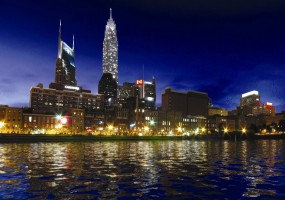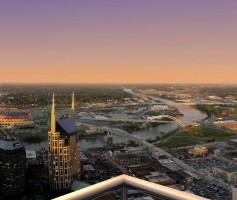
Signature Tower in Downtown Nashville
This article entitled “The Signature Tower and May Town Center are far from sure things. Is Tony Giarratana’s legacy as Nashville’s development king up in the air?” appeared in the Nashville Scene on August the 5th, 2009. The author is Caleb Hannan:
“The setting: Atlanta. The time: Sometime after the turn of the century. The scene: Tony Giarratana is walking around the city, tape measure in hand.
He is looking for inspiration. Back in Nashville, the developer owns a great piece of real estate. It’s adjacent to the iconic Life & Casualty Tower, the limestone skyscraper that re-established the city as the Wall Street of the South when built in 1957. There’s just one thing he needs now: a clear vision of what he’s going to build.
For Giarratana, that’s a problem. Ever since he was a little boy, he’s needed to see a picture in his head before going any further with a project. The gift of visualization was inherited, he says, from a father who dabbled in ecclesiastical painting.
Suddenly, he spots it—The Metropolis. A midtown glass-and-concrete high-rise that, at first glance, seems a snug fit for his footprint back home. A quick pull on the tape confirms his instinct: It’s a perfect match.
Now Giarratana has the vision. All that remains now is to join forces with the firm that built it, and carry the plan back up I-24. He will plant this seed of imagination. Soon it will grow into the 31-story Viridian, a condo that will shore up his reputation as Nashville’s answer to The Donald.
Better still, he now has a story to sell. Variations on the tape measure tale have circulated through Nashville since the building was completed three years ago. In Giarratana’s official version, the tape measure is the 300-footer he keeps in his car trunk. And although the Metropolis was ultimately his muse, the structure he says he actually measured was a parking garage.
But no matter which iteration gets told, the subtext remains the same: It’s the latest chapter in the tale of a can-do visionary who succeeds using unconventional tactics, not another tailored suit looking to make a buck. It is an image he has literally taken to the bank.
At a youthful 52 years old, Tony Giarratana is the most visible developer in all of Nashville. He shoots big, rolls high. His projects rarely move quietly into the neighborhood. They alter the landscape forever, or change the city’s skyline. They leave permanent marks.
But in a quirk of timing, Giarratana has become the public face of two of the most controversial development projects of the past decade in Nashville. One is the Signature Tower, the downtown skyscraper originally intended to dwarf every building in the Southeast. The other is the hotly contested May Town Center, the Field of Dreams satellite city in bucolic Bells Bend, which has divided Nashville like no development issue in years.
In one sense, Giarratana is well suited to these high-risk, high-visibility, high-shouting-volume projects. With a disarming combination of attrition and charm, he has turned would-be adversaries into grudging admirers. “Even when we’ve been on opposite sides of the aisle, Tony has always gone out of his way to reach out and try to find common ground,” says Ann Roberts, who served as director of the Metro Historical Commission for 26 years. “He’s very personable, very persuasive.”
I am a little turned off by this description of Mr. Giarratana, he and I have had our differences in the past, but this is taking much out of context. Granted, Mr. Giarratana has always swung for the fences, but what would you rather he do? Would you rather he build monotonous suburban strip centers like every other idiot developer without a vision?
Now, however, his two career-defining projects are on the brink of becoming massive public fiascos. The Signature Tower, a landmark meant to signal Nashville’s literal ascent over rival Atlanta to join the big boys, has stalled yet again. Certainly the current recession is a major factor. But critics say the tower’s shifting plans and scattered focus have done little to boost the faith of backers.
May Town Center is even more problematic. Were anybody else but Giarratana involved, the project’s initial zoning blow might have killed the deal. But in a surprise maneuver two weeks ago, the project’s backers requested another hearing, then withdrew at the last minute, thereby gaining 60 days to reapply for a key zoning change – a tactic that could make his $4 billion second downtown a reality.
This just seems like good business practices to me, even though I am personally against the project.
In attempting to get projects like May Town and Signature off the ground, Giarratana has used his salesman’s skill to convince skeptical politicians, neighborhood activists and planners that his vision can be trusted. Time and time again, he and his supporters, whether paid or volunteer, invoke his “proven record of success.”
But amid undeniable successes, a look at Giarratana’s impact on Nashville since the late 1980s yields mixed results – a legacy that dates back to his first bitterly contested major project and culminates in the current flaps over May Town Center and the Signature Tower.
In reviewing his two-decade career in Nashville, the Scene has talked to those who, like Giarratana, have played critical roles in shaping the city: real estate lawyers, preservationists, fellow developers, architects and designers. Owing to the considerable power he wields, few are willing to speak publicly. Fewer still would speak on the record.
Despite their reticence, though, they provide a portrait of an incredibly talented salesman, a charmer whose belief in himself and his product is devout. And also a man whose recent controversies aren’t the exception to the rule – they are the rule.
The ‘talented salesman’ reference is not invoking the slimy image as intended. I can only think of the fact that it is a smart move to sell projects of this magnitude to city leaders and the public before turning dirt. Isn’t this exactly what you would do?
It can all be traced back to 1988, when Giarratana made his first big play to change the Nashville skyline. Before he came here, Giarratana had plied his trade in Tampa Bay, Denver and New Orleans. He began his career in Nashville working for Aladdin Resources, the developer of MetroCenter. He left within a year, intending to raise enough money for a building of his own.
Giarratana got his chance when, along with a group of investors, he bought two historic properties on once-thriving Church Street: the Sudekum Building and the Tennessee Theater, two of the few remaining Art Deco structures in the country.
For years, efforts had been made to develop the properties. The only thing standing in the way was the Odd Fellows.
A fraternal society not unlike the Freemasons, the Odd Fellows mostly kept a low profile doing small-scale charitable work – scholarships from anonymous donors more than Skull and Bones globe-shaking. With a 99-year lease on the Sudekum, any potential developers first had to convince the 50 or so members to relinquish their rights to the building. Everybody who tried had failed.
Enter Giarratana.
“He came across as very nicely dressed, a well-spoken salesman,” says Dan McCollum, a former Odd Fellow. “He said he was going to take care of us.”
According to McCollum, Giarratana promised the Odd Fellows premium office space and a share of the profit that would come from his as-yet unbuilt building, 555 Church. The offer proved favorable enough to convinced the Odd Fellows to sell. Then Giarratana went looking for more tenants.

Signature Tower Pool
At the time, Nashville’s downtown was nearly deserted. The heart of the city’s shopping district for most of the century, Church Street, like so many other urban districts around the country, had lost its customer base to the pull of suburban malls like Green Hills and Hickory Hollow.
As a result, Giarratana and other developers had little leverage in trying to convince companies to work in the proposed building. Giarratana found a Nashville law firm, Manier & Herod, willing to move in – if he would pay them money up front to sign a lease.
“It’s done differently now,” says a longtime Nashville attorney familiar with the negotiations. “But back then you literally had to buy your tenants.”
After negotiating a contract, Giarratana was all set to meet with the law firm’s partners. Minutes before the meeting was to begin, however, he called with a new proposal. The lawyers were shocked to hear his revised offer: He wanted them to accept a note – essentially an I.O.U. instead of cash.
“People in the room were saying, ‘Can you believe this guy?’ ” recalls a lawyer who was present when they got the offer. “Tony swore up and down that he had the money, then waits till the last minute to tell us he can’t pay.”
“The specific office lease you referenced was not signed because the proposed tenant was either unwilling or unable to guaranty or otherwise secure its lease obligation,” Giarratana responded by email. “This was simply not a negotiable point. Construction financing for large-scale real estate developments based on an unsecured lease obligation was not available in the late 80s/early 90s, nor would such construction financing be available today.”
As it turned out, Giarratana couldn’t pay anybody. In 1992, the developer filed for bankruptcy. By that time, he had already demolished the Sudekum Building and the Tennessee Theater – a move that for years made his name synonymous with Nashville’s reckless disregard for historic downtown properties.
In his Chapter 7 statements, filed in January 1992, Giarratana listed such assets as a Park Circle condo and half a speedboat. A wedding band, cuff links and a Seiko watch. A bank account with $4.42 and a scuba diving set. He also listed debts of nearly $600,000.
Months prior, H.A.W. Inc., a demolition company out of Lewisburg, had obtained a $150,000 judgment for non-payment against three partnerships that, for all intents and purposes, were owned by Giarratana and his investors.
H.A.W. had spent 10 months painstakingly removing asbestos from the Tennessee Theater, to prevent the harmful carcinogen from going airborne when the building fell. When Giarratana filed for bankruptcy, they went after him personally to recover their money.
In interrogatories filed by H.A.W.’s lawyers and obtained by the Scene, the company went digging through Giarratana’s financial disclosures. They even asked about a property not even listed in the bankruptcy proceedings: the intended site of 555 Church Street, which no longer belonged to the mogul. On Oct. 16, 1991, less than a year before his bankruptcy filing, a joint venture of which Giarratana was president had transferred ownership of the Church Street property to a limited partnership called 555 Partners. Original investors in the property made up half of the new partnership. The other half was owned by a corporation, of which Giarratana’s wife Lisa was the sole shareholder.
Creative genius and duplicitous aversion all at the same time. You have to respect a business move like that even though it may wrench your gut too.
The interrogatories don’t specify what H.A.W. and its attorneys hoped to find. Whatever the case, H.A.W.’s lawyers spent six months filing extensions while sorting through the myriad complexities of high-stakes real-estate financing. Nearly a year after receiving their judgment, H.A.W. called Giarratana in for a deposition. It was not an amicable meeting.
“Tony exploded,” recalls one witness. “He went into a rage.”
But if H.A.W. hoped to land some kind of knockout blow, it evidently failed. According to informed sources, H.A.W. eventually settled with Giarratana, but at a substantial loss.
In response to inquiries about this period, Giarratana offered a prepared statement: “I decline from discussing my personal financial matters of nearly 20 years ago. These issues were well reported at the time and I view the Nashville Scene’s renewed interest in them now with suspicion.”
In a later email statement, Giarratana wrote, “With regard to my bankruptcy, which occurred 17 years ago, I have no interest in reliving an extremely painful period of my life; one that was widely publicized at the time. All documentation regarding the bankruptcy proceedings were part of the public record at the time and were approved by the bankruptcy court. It is outrageous for the Scene or anyone else to insinuate through commentary or speculation that anything was done inappropriately.”
As for the Odd Fellows, according to McCollum, the three-year ordeal left the charitable organization without land, a place to meet, or the money to keep going as they had before. Initially, per their agreement, McCollum says Giarratana had provided a new meeting space on Fesslers Lane. When he filed for bankruptcy, that obligation ended.
McCollum says the Odd Fellows bought a place on Dickerson Pike in an effort to keep the group together. But the older women who belonged to their co-ed group were afraid of the new office’s proximity to what was then a reputed hotbed of vice, says McCollum, and membership dwindled.
“In Tony’s rush to get something built we wound up with nothing,” he says. “It broke the back of the local.”
Eventually Giarratana got his Church Street property built, even if it took a full decade after he made public his plans to build an office tower. In 1998, he opened the Cumberland, a 24-story condominium meant to be the dawn of a new resurgence of downtown living.
This was indeed a historic structure, not for its architectural significance, but for the fact that it was the first even residential high-rise built in Nashville’s urban core.

Lobby of Giarratana’s Signature Tower
But the project presented even more problems. It took two years, twice as long as intended, to fully lease the Cumberland’s 289 units. Worse, the building’s exterior, built from a cheap stucco substitute known as EIFS, was reviled as a blight upon the city’s downtown, a sorry replacement for the historic structures the developer razed. The most damning description came from Scene writer Christine Kreyling, who called its architectural style “East Berlin before the wall came down.”
The combination of slow sales and an aesthetic pockmark on the city’s skyline convinced some that Giarratana’s first big score – the building The Tennessean would applaud for being “the genesis of his comeback as a residential developer” – actually hurt efforts to attract downtown dwellers.
“Prior to Cumberland, there was lots of skepticism about a high-rise apartment project,” says a developer with decades of experience in Nashville. “Tony, because he executed it so poorly, sort of proved it was a mistake to have done it. Some think he set back downtown living for years because of it.”
I hate to say it, but this is a debate that Giarratana would win. Who else has put their money where their mouth is in downtown?
The success of the Cumberland was up for debate. The successes of Giarratana’s next big projects were not.
His brand new Belle Meade Town Center actually managed to preserve the historic Belle Meade Theater and its landmark facade, and his conversion of the 82-year-old Bennie Dillon Building into downtown lofts saved one of Church Street’s most distinctive structures. By all accounts, the 31-story Viridian, opened in 2006, and the 20-story Encore!, opened last year across from Schermerhorn Symphony Center, have done phenomenally well. The former sold out eight months before it opened. The latter boasts 80 percent occupancy.
The last three projects, however, were all handled in partnership with the Atlanta-based development firm Novare Group. Originally Giarratana wanted to go solo on the Viridian. But according to sources familiar with the project, contractor R.J. Griffin was wary of working with him alone. Griffin brokered a meeting with Novare president Jim Borders, and an agreement was reached.
“The smartest thing Tony ever did was partner up with Novare, because he was able to let them do the heavy lifting,” says one downtown developer.
I’m not so sure about that, I read Novare’s letter to their investors and it looks they will be filing for the ‘big B’ by the end of the year.
Yet even Giarratana’s critics concede he did a masterful job of his chief objective: winning hearts and minds. “Tony is, if nothing else, one of the best salesmen you’ll ever see,” says an architect who has worked with Giarratana.
Stories of his irrepressible sales instincts are legion. Before the Viridian opened, he was invited by Nashville Lifestyles magazine to a combination salon/supper club gathering of civic leaders. The point was to get four or five experts together in an informal setting over dinner, then print the transcript of the ensuing conversation. Because the topic was downtown development, Giarratana was a natural choice to fill a seat.
The others came prepared to eat. Giarratana came prepared to wow. When he arrived at the ritzy Palm for the dinner, he unveiled his date: a 4-foot model of the Viridian.
“It’s like he couldn’t shut it off, even for one night,” another dinner guest says.
He’ll need every ounce of that skill for his two highly public current projects. The stakes are astronomical. And at present, there are more than a few pressing matters facing Giarratana. There’s the $53,000 arbitration judgment leveled against him by an Atlanta marketing firm, which alleges it was stiffed for work it did on behalf of Signature Tower. There’s the vote against May Town Center, which may cost him a reported $1.5 million if he fails to get approval of a zoning change that would have given the project a green light. [I am sure that May family will shoulder that cost]
There’s also the $2.25 million lawsuit he filed against nationally ranked Top 100 design firm Gresham Smith and Partners. Giarratana contends that “substandard” planning by the Nashville-based firm led to costly delays for his Belle Meade Town Center project. Gresham Smith declined to comment on the suit.
But chances are none of those potential problems compares to the boondoggle that is Signature Tower.
The former home of the Cain-Sloan department store has undergone a number of iterations in the past five years. It started life as a 55-story office building with condos and a boutique hotel. Then it gained an extra 10 stories, topping the structure it somewhat resembles, New York City’s Chrysler Building. Finally, it leveled off at 70 stories – tall enough to require the FAA to change air traffic patterns.
I believe that the FAA air traffic problem was a total rumor.
“Tony’s Achilles’ heel, his big mistake, is that he’s always sort of yearned to be the developer,” says a competitor. “Signature Tower was his undoing because it was a massively big deal, unbelievably overreaching.”
But it may not matter how high Giarratana aims to build. Judging by its history, Signature Tower may never get off the ground.

Views From Top of Signature Tower
The grand Signature has already been scaled down from its record-setting heights – from the tallest building in the Southeast to the tallest in Nashville. As currently proposed, it would stand 20 stories shorter than the original plan. It would also contain 50 condo units, scaled back from the 400 intended at first. Just last month, Giarratana defaulted on an $11.5 million loan from Wachovia – for at least the second time, as the Nashville Business Journal reported.
The same developers, lawyers and architects who feel compelled to talk, just not on the record, say that a combination of Giarratana’s May Town failings, the sunk cost that is Signature and a historically bad market might have calamitous results for the development mogul.
“He convinces himself he can do things he can’t do. And he ought to know he can’t do it,” says a local attorney. “There should be a reality brake in there somewhere and it doesn’t kick in. Signature Tower is probably the ultimate expression of that. He’s like an Ayn Rand character. There’s a lot of The Fountainhead in him.”
His other large project of the moment, May Town Center, has engendered heated opposition and disagreement at almost every step – from its contentious public hearings to a potential land allotment to TSU mired in uncertainty. Giarratana remains optimistic about May Town’s prospects. “Just what is it you disagree with?” he asked in an email last week, which addressed the Scene in particular but also took note of the project’s opponents.
“Is it corporate retention/relocation?” he writes. “Job creation? Expansion of Nashville’s tax base? Sustainable development? Opportunity for North Nashville? Or the TSU research park and sustainable agricultural research farm?”
Giarratana’s questions were posed to David Briley, the former councilman and mayoral candidate widely viewed as the head of May Town’s opposition.
“I don’t fault Tony for making the best case he can for the project,” Briley says. “That’s what he was hired to do. But that doesn’t mean we as a community have to accept his representations at face value. It’s a sales pitch. He’s being a salesman.”
Whatever has been said or written about Giarratana up until now, the fact remains that the city’s biggest name in development still has a chance to make two significant additions to his résumé.
Despite a bankruptcy, despite the stumble out of the gates with the Cumberland, despite the plunging vital signs for his two most ambitious projects, not to mention a dire financial forecast – despite all that, if Giarratana can somehow reverse course and find a way to build both Signature Tower and May Town Center, his legacy will once again be rewritten.
But even on this scale, one man’s triumph isn’t necessarily a tide that raises all boats. Given the checkered example of the Cumberland and the city-changing implications of the Signature Tower and May Town Center, whose alterations cannot be undone, Nashville may do well to wonder whether it’s worse if Tony Giarratana doesn’t succeed – or if he does.”


